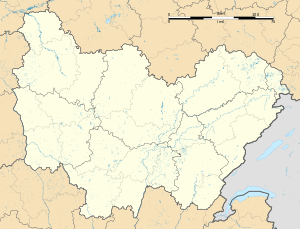Bretonvillers
Bretonvillers is a commune in the Doubs department in the Bourgogne-Bourgogne-Franche-Comté region in eastern France.
Bretonvillers | |
|---|---|
Location of Bretonvillers 
| |
 Bretonvillers  Bretonvillers | |
| Coordinates: 47°13′08″N 6°38′15″E | |
| Country | France |
| Region | Bourgogne-Franche-Comté |
| Department | Doubs |
| Arrondissement | Pontarlier |
| Canton | Valdahon |
| Intercommunality | Entre Dessoubre et Barbèche |
| Government | |
| • Mayor (2008–2014) | Daniel Mougin |
| Area 1 | 13.66 km2 (5.27 sq mi) |
| Population (2017-01-01)[1] | 276 |
| • Density | 20/km2 (52/sq mi) |
| Time zone | UTC+01:00 (CET) |
| • Summer (DST) | UTC+02:00 (CEST) |
| INSEE/Postal code | 25095 /25380 |
| Elevation | 445–922 m (1,460–3,025 ft) |
| 1 French Land Register data, which excludes lakes, ponds, glaciers > 1 km2 (0.386 sq mi or 247 acres) and river estuaries. | |
Population
| Year | Pop. | ±% |
|---|---|---|
| 1962 | 379 | — |
| 1968 | 362 | −4.5% |
| 1975 | 308 | −14.9% |
| 1982 | 251 | −18.5% |
| 1990 | 236 | −6.0% |
| 1999 | 240 | +1.7% |
| 2008 | 225 | −6.2% |
| 2012 | 248 | +10.2% |
gollark: Not specifically wordpress, no.
gollark: I would probably use nginx, because I'm used to it and it has nicer configuration:```nginxhttp { # whatever important configuration you have for all HTTP servers, `nginx.conf` probably ships with some # fallback in case someone visits with an unrecognized Host header server { listen 80 default_server; listen [::]:80 default_server; return 301 http://somedomain$request_uri; } server { listen 80; # you may (probably do) want HTTPS instead, in which case this bit is somewhat different - you need to deal with certs and stuff, and use port 443 - also you should probably add HTTP/2 listen [::]:80; # IPv6 server_name domain1.com; location / { proxy_pass http://backend1:8080/; } } server { listen 80; listen [::]:80; server_name domain2.com; location / { proxy_pass http://backend2:8080/; } }}```
gollark: The reverse-proxy solution is in my opinion the best one, although it would require some config.
gollark: I think LetsEncrypt may not be very happy with that, though.
gollark: Yes, and you can just use a reverse proxy (with "vhosts" or whatever) for that, easy enough.
See also
References
- "Populations légales 2017". INSEE. Retrieved 6 January 2020.
| Wikimedia Commons has media related to Bretonvillers. |
This article is issued from Wikipedia. The text is licensed under Creative Commons - Attribution - Sharealike. Additional terms may apply for the media files.